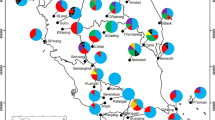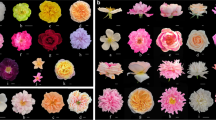Abstract
Siberian Pine (Pinus sibirica) is an ecologically and economically important species in pristine forests throughout northern Russia. Four provenances of P. sibirica were introduced from Mongolia and Russia to the Greater Xing’an Range (the Daxing’anling), northeast China in 1993. The aim of this research was to study genetic variation and selection of the introduced four Pinus sibirica provenances. Heights (H), basal diameters (BD), survival rates (SR) and crown lengths (CL) of different families were measured as primary outcomes in different growth years. Results of data analyses demonstrated high coefficients of phenotypic variation (PCV) and heritability (H 2) for H, BD and CL at 18 years after introduction. PCV and H 2 increased with age. Correlations of growth traits between any two growth years were all significantly positive, but the correlation coefficient was smaller when the growth year interval was larger. Correlations between H and the original environment factors decreased gradually, indicating that with long-term subsistence in the new environment, the influence of the source environment declined. Colligation of multiple traits to estimate provenances showed that Novosibirsk, Tomsk, and Altai Mountains had higher survival rates and biomass, and proved more suitable for introduction and plantation in the Greater Xing’an Range in China.
Similar content being viewed by others
References
Alantsev NK. 1981. The stone pine. Moscow: Forestry Industry Press, pp. 60–61.
Carrasquinho I, Gonçalves E. 2013. Genetic variability among Pinus pinea L. provenances for survival and growth traits in Portugal. Tree Genetics & Genomes, 9: 855–866.
Chandrababu RJ, Sharma RK. 1999. Heritability estimates in almond [Prunus dulcis (Miller) D.A. Webb]. Scientia Horticulturae, 79: 237–243.
Danusevicius J. 2001. Use of introduced provenances to increase genetic diversity in local scots pine populations. Biologija, 1: 59–61.
Engelmark O, Sjoberg K, Andersson B, Rosvall O, Agren G, Baker W, Barklund P, Bjorkman C, Despain D, Elfving B, Ennos R, Karlman M, Knecht M, Kinght D, Ledgard N, Lindelow A, Nilsson C, Peterken G, Sorlin S, Sykes M. 2001. Ecological effects and management aspects of an exotic tree species: the case of lodgepole pine in Sweden. Forest Ecol Manag, 141: 3–13
Grattapaglia D, Resende MD. 2011. Genomic selection in forest tree breeding. Tree Genetics and Genomes, 7: 241–255.
Gonçalves P, Bortoletto N, Cardinal A, Gouvea L, Costa R, Moraes M. 2005. Age-age correlation for early selection of rubber tree genotypes in Sao Paulo State, Brazil. Genet Mol Biol, 28: 758–764.
Gonçalves P, Bortoletto N, Fonseca F, Bataglia O, Ortolani A. 1998. Early selection for growth vigour in rubber tree genotypes in Northwestern Sao Paulo State (Brazil). Genet Mol Biol, 21: 515–521.
Gur A, Zamir D. 2004. Unused natural variation can lift yield barriers in plant breeding. PLoS Biol. 2(10) e245. Doi: 10.1371/journal.pbio.0020245
Hai PH, Jansson G, Harwood C, Hannrup B, Thinh H. 2008. Genetic variation in growth, stem straightness and branch thickness in clonal trials of Acacia auriculiformis at three contrasting sites in Vietnam. For Ecol Manag, 255: 156–167.
Hansen JK, Roulund H. 1996. Genetic parameters for spiral grain, stem form, Pilodyn and growth in 13 year old clones of Sitka Spruce (Picea sitchensis (Bong.) Carr.). Silvae Genet, 46: 107–113
Isaev AS. 1985. Stone pine forest in Siberian. The USSR academy of science, Novosibirsk. P. 30.
Iroshnikov AI, Politov DV. 2004. Five-needle pines in Russia: Introduction and breeding. USDA Forest Service Proceedings RMRS-P-32: 64–72.
King JN, Burdon RD. 1991. Time trends in inheritance and projected efficiencies of early selection in a large 17-year old progeny test of Pinus radiata. Can J For Res, 21: 1200–1207.
Krylov GV, Talantsev NK, Kozakova NF. 1983. The cedar [“Kedr”]. Moscow: Forestry Industry Press.73–34.
Li JY, Brunner AM, Meilan R, Strauss S. 2008. Stability of transgenes in trees: expression of two reporter genes in poplar over three field seasons. Tree Physiology, 29: 299–312.
Mack RN, Lonsdale WM. 2001. Humans as global plant dispersers: getting more than we bargained for. BioScience, 51: 95–102.
Matheson A, Spencer DJ, Magnussen D. 1994. Optimum age for selection in Pinus radiata using basal area under bark for age:age correlations. Silvae Gen, 43: 352–357.
Marron N, Ceulemans R. 2006. Genetic variation of leaf traits related to productivity in a Populus deltoides×Populus nigra family. Can J For Res, 36: 390–400.
Neale DB. 2007. Genomics to tree breeding and forest health. Current Opinion in Genetics and Development, 17: 539–544.
Peterken GF. 2001. Ecological effects of introduced tree species in Britain. For Ecol Manag, 141: 31–42.
Pliura A, Zhang SY, Mackay J, Bousquet J. 2007. Genotypic variation in wood density and growth traits of poplar hybrids at four clonal trials. For Ecol Manag, 238: 92–106.
Politov DV, Krutovsky KV. 2004. Phylogenetics, genogeography and hybridization of five-needle pines in Russia and neighboring countries. USDA Forest Service Proceedings RMRS-P-32, 85–97.
Wu HX, Eldridge KG, Matheson AC, Powell MB, Mcrae TA, Butcher TB, Johnson IG, Wu XH, Eldridge KG, Matheson AC, Powell MB. 2007. Achievements in forest tree improvement in Australia and New Zealand-Successful introduction and breeding of radiata pine in Australia. Australian forestry, 70(4): 215
Zhao XY, Ma KF, Shen YB, Zhang M, Li KY, Wu RL, Zhang ZY. 2012. Characteristic variation and selection of forepart hybrid clones of Sect. Populus. Journal of Beijing Forestry University, 34: 45–51.
Author information
Authors and Affiliations
Corresponding author
Additional information
Project funding: This work was supported by grants Seedling Technology Rules of Siberia pine (No.2012-LY-183).
Rights and permissions
About this article
Cite this article
Zhao, X., Wang, C., Li, S. et al. Genetic variation and selection of introduced provenances of Siberian Pine (Pinus sibirica) in frigid regions of the Greater Xing’an Range, Northeast China. Journal of Forestry Research 25, 549–556 (2014). https://doi.org/10.1007/s11676-014-0494-6
Received:
Accepted:
Published:
Issue Date:
DOI: https://doi.org/10.1007/s11676-014-0494-6




